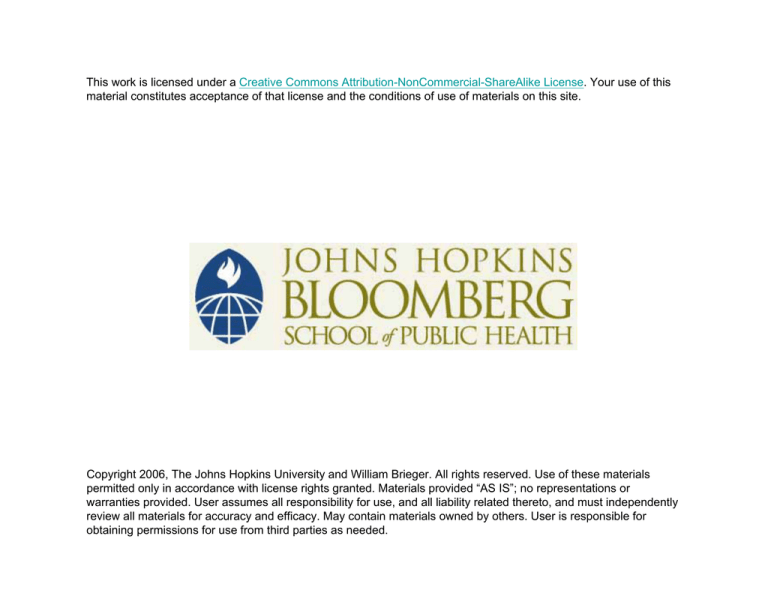
This work is licensed under a Creative Commons Attribution-NonCommercial-ShareAlike License. Your use of this
material constitutes acceptance of that license and the conditions of use of materials on this site.
Copyright 2006, The Johns Hopkins University and William Brieger. All rights reserved. Use of these materials
permitted only in accordance with license rights granted. Materials provided “AS IS”; no representations or
warranties provided. User assumes all responsibility for use, and all liability related thereto, and must independently
review all materials for accuracy and efficacy. May contain materials owned by others. User is responsible for
obtaining permissions for use from third parties as needed.
Approaches to Training and Learning
William Brieger, MPH, CHES, DrPH
Johns Hopkins University
Overview
This lecture looks at two issues
First, some principles of learning will be explored
Ë Gerald J. Pine and Peter J. Horn
Secondly, adult education approaches to training and
learning will be examined
Ë Malcolm Knowles
2
Section A
Principles of Learning, Part 1
Principles of Learning
Learning is an internal process
Learning is a discovery of meaning
Learning is a consequence of experience
Learning involves cooperation, collaboration
Learning is evolutionary, a slow process
Continued
4
Principles of Learning
Behavior change can be painful
The learner is a rich resource
Learning is emotional and intellectual
Ë “People problems” must be addressed
Individuals have unique learning styles
5
Principle 1
Learning is an experience which occurs inside the learner
and is activated by the learner
The process of learning is primarily controlled by the
learner
Changes in perception and behavior are more products
of human meaning and perceiving rather than any forces
exerted upon the individual
Continued
6
Principle 1
The learner has to do with
something, which happens in
the unique world of the
learner
Health workers may
resist learning new
record keeping skills
unless these are seen
to have meaning
Continued
7
Principle 1
Teaching is seen as a facilitating process that assists
people to explore and discover the personal meaning of
events for them
No one directly teaches anyone anything of significance
8
Principle 2
Learning is the discovery of
the personal meaning and
relevance of ideas
People more readily
internalize and implement
concepts and ideas which are
relevant to their needs and
problems
Training patent medicine
sellers builds on experience
and provides relevant skills
Continued
9
Principle 2
Learning requires the exploration of ideas in relation to
self and community so that people can determine:
Ë What their needs are
Ë What goals they would like to formulate
Ë What issues they would like to discuss
Ë What content they would like to learn
10
Principle 3
Learning (behavioral change) is a consequence of
experience
People
Ë Become responsible when they have really
assumed responsibility
Ë Become independent they have experienced
independent behavior
Ë Become able when they have experienced success
Continued
11
Principle 3
People
Ë Begin to feel important when they are important to
somebody
Ë Feel liked when someone likes them
Ë Do not change their behavior merely because someone
tells them to do so or tells them how to change
For effective learning, giving information is not enough
Continued
12
Principle 3
People become responsible and independent
Ë Not from having other people tell them that they
should be responsible and independent— but from
having experienced authentic responsibility and
independence
Training can help health
workers feel responsible
for analyzing and using
the data they collect
13
Principle 4
Learning is a cooperative and collaborative process
Cooperation fosters learning: “two heads are better than
one”
People enjoy functioning interdependently
The interactive process appears to “scratch and nick”
people’s curiosity, potential, and creativity
Continued
14
Principle 4
Cooperative
approaches are
enabling
People learn to
define goals, to plan,
to interact, and to try
group arrangements
in problem solving
Training should offer opportunities
to share and collaborate on
problem solving
Continued
15
Principle 4
Paradoxically, as people invest themselves in
collaborative group approaches, they develop a firmer
sense of their own identification
They begin to realize that they count, that they have
something to give and to learn
Problems which are identified and delineated through
cooperative interaction appear to challenge and stretch
people to produce creative solutions and to become
more creative individuals
16
Section B
Principles of Learning, Part 2
Principle 5
Learning is an evolutionary process
Behavioral change requires time and patience
When quick changes in behavior are demanded
Ë We often resort to highly structured procedures
through which we attempt to impose learning
Whether such learning is lasting and meaningful to the
learner is doubtful
Implicit in all the principles and conditions for learning is
an evolutionary model of learning
18
Principle 5: Learning Situations Are Characterized By
Free and open
communication
Cooperation and
collaboration
Confrontation
Ambiguity
Acceptance
Shared evaluation
Respect
Active and personal
involvement
The right to make mistakes
Self-revelation
Freedom from threat
Trust in the self
All evolutionary in nature
Continued
19
Principle 5: Learning Situations Are Characterized By
Free and open
communication
Cooperation and
collaboration
Confrontation
Ambiguity
Acceptance
Shared evaluation
Respect
Active and personal
involvement
The right to make mistakes
Self-revelation
Freedom from threat
Trust in the self
All evolutionary in nature
20
Principle 6
Learning is sometimes a painful process
Behavioral change often calls for giving up the old,
comfortable ways of believing, thinking, and valuing
It is not easy to discard familiar ways of doing things and
incorporate new behavior
However, the pain of breaking away from the old and the
comfortable is usually followed by appreciation and
pleasure in the discovery of an evolving idea or a
changing self
21
Principle 7
One of the richest resources for learning is the learner
himself
In a day and age when so much emphasis is being placed
upon instructional media, books, and speakers as
resources for learning, we tend to overlook perhaps the
richest resource of all—the learner himself
Continued
22
Principle 7
Each individual has an
accumulation of
experiences, ideas,
feelings, attitudes …
which comprise a rich
vein of material for
problem solving and
learning
Photo by Olalekan Azeez
Youth learn about violence and
sexual coercion through sharing
their own experiences and
developing drama to educate
others
Continued
23
Principle 7
Learning situations need to enable people
Ë To become open to themselves
Ë To draw upon their personal collection of data
Ë To share their data in cooperative interaction with
others to maximize learning
24
Principle 8
The process of learning is emotional as well as
intellectual
Learning is affected by the total state of the individual
People are feeling beings as well as thinking beings
Ë When their feelings and thoughts are in harmony,
learning is maximized
To create the optimal conditions in a group for learning
to occur, people must come before purpose
Continued
25
Principle 8
Regardless of the purpose of a group, it cannot be
effectively accomplished when other things get in the
way
Barriers to communication exist in people
Ë Before we can conduct “official business,” we need
to work with the people problems that may exist in
a group
To maximize the acquisition and internalization of ideas,
it seems reasonable that the people problems would
have to be dealt with first
26
Principle 9
The processes of problem-solving learning are highly
unique and individual
Each person has his own unique styles of learning and
problem solving
Ë Some personal styles of learning and problemsolving are highly effective
Ë Other styles are not as effective
Ë Still others may be ineffective
Continued
27
Principle 9
Learners need
recognize the
approaches they
ordinarily use so that
they can become more
effective in problem
solving
Training experiences should expose
learners to different approaches to
learning
Continued
28
Principle 9
As people become aware of how they learn and
experience new models, they define and modify their
personal styles so that these can be employed more
effectively
29
Section C
Adult Education Approaches
Adult Learning Assumptions
Continued
31
Adult Learning Assumptions
32
Retention in Adult Learning
ng
Te
ac
hi
ct
ic e
Pr
a
s io
n
sc
us
Di
tio
n
m
on
st
ra
De
su
al
s
Au
di
ov
i
g
Re
ad
in
Le
ct
ur
e
100
90
80
70
60
50
40
30
20
10
0
Copyright 2005, Bill Brieger and The Johns Hopkins University. All rights reserved. Use of these materials
permitted only in accordance with license rights granted. Materials provided “AS IS”; no representations or
warranties provided. User assumes all responsibility for use, and all liability related thereto, and must
independently review all materials for accuracy and efficacy. May contain materials owned by others. User is
responsible for obtaining permissions for use from third parties as needed. Unless otherwise stated, all photos are
the property of Bill Brieger.
33





